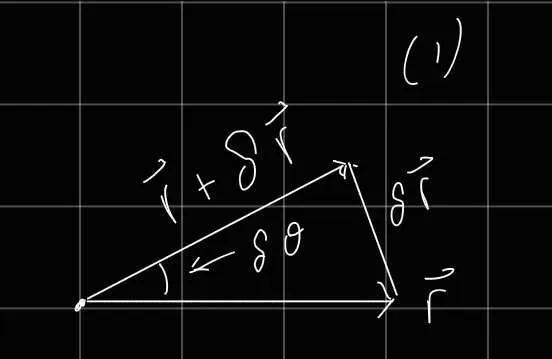Exam Logistics
- Tuesday 2/13 form 8-9:50
- 4 problems, each problem should be ~ half hour
- Concepts covered
- 2024-01-03 Classical Review
- 2024-01-19 Special Relativity
- Have numbers in it, will be simple numbers
- Boost Equations
- Length contraction/time dilation equations
- Velocity transformations
- 2024-01-23 Lagrangian Mechanics
- Not doing forces of constraint
- 2 problems on Lagrangian Mechanics, 1 on classical review, one on special relativity.
- No calculators, no crib sheet
- Any non-standard integral will be given
- Use problems in the book for review
Conservation of Angular Momentum
Continued from 2024-02-06 Hamilton and Conservation
- Lagrangian is invariant under rotation
- For some vector

Then
Plug eqs 1 and 2 into 0
We can use the dot product to simplify this into the following:
Simplify with chain rule
Angular Momentum formulas
Angular momentum is conserved if L is invariant under rotation. If a system is symmetric about an axis, then angular momentum in that direction (of axis ) is conserved.
Examples with uniform circular motion
in x-y plane
- Symmetry about z-axis, so is conserved Cylindrical symmetry conserved. Spherical symmetry constant
goddamn
Hamilton Dynamics
Canonical (inherent) equations of motion. For example, the canonical equation of motion for Lagrangian mechanics is the Euler-Lagrange Equation
Aside: Hamiltonian mechanics and dynamics are very useful for things that are not classical. They are, however, very useful for quantum physics. It produces first order differential equations, which was very useful hundreds of years ago when computers didn’t exist.
Transforming the Lagrangian into the Hamiltonian The Lagrangian is a function of position, velocity and time
Hamiltonian equations of motion:
if
if
Example: Free particle of mass m in 1 dimension
Need generalized momentum. Ignore weird part above, i couldnt really read his handwriting.
This is not correct! no velocity allowed
Which is equiv. to
Example Harmonic oscillator
This is not the Hamiltonian! Has velocity, not momentum
Alternative:
Choose coordinates such that H is cyclic
What the fuck is this.
\dot{Q} = \omega t + \phi $$Go back?p=\sqrt{ 2mE } \cos(\omega t+\phi)
x = \sqrt{ \frac{2E}{m\omega^{2}} } \sin(\omega t+\phi)
### Conservation Laws - For a given variable, q, p or t, to see if that quantity is conserved we should check the total time derivative. - $F(q,p,t)$ general function of $q_{i},P_{i}$ and $t$\frac{ d F }{ d t } = \frac{ d F }{ d t } + \sum_{i} \left( \frac{ d F }{ d q_{i} } \dot{q}{i} + \frac{ d F }{ d P{i} }\dot{P}_{i} \right)
\frac{dF}{dt} = \frac{ d F }{ d t } + \sum_{i}\left[ \frac{ \partial F }{ \partial q_{i} } \frac{ \partial H }{ \partial P_{i} }-\frac{ \partial F }{ \partial P_{i} }\frac{ \partial H }{ \partial q_{i} } \right]
\left[ \frac{ \partial F }{ \partial q_{i} } \frac{ \partial H }{ \partial P_{i} }-\frac{ \partial F }{ \partial P_{i} }\frac{ \partial H }{ \partial q_{i} } \right] \equiv {H,F}
F is conserved if $\frac{dF}{dt}=0$ Implies $\frac{ d F }{ d t }=0 \to \{H,F\}=0$ This is especially useful when we transition from classical to quantum mechanics. For a problem 1. Determine the classical Hamiltonian 2. Transition by replacing q and p by their operators{H,q}=[\hat{H}\hat{Q}-\hat{Q}\hat{H}]
q \to \hat{Q}
p \to \hat{P}
p_{x} = i\hbar \frac{d}{dx}